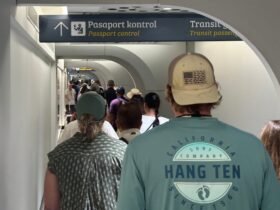The growth of blended travel is undeniable, and accounting for which part was for business and which for leisure has been a pain point for both employers and employees.
“One of the main frustrations with bleisure travel has always been keeping business and personal expenses clearly separated,” said Yuval Refua, Navan’s chief product officer, payments & expense.“Traditionally, employees might have to pay out-of-pocket or with a company credit card and later submit reimbursement requests, leaving finance and accounting teams to untangle what’s work and what’s leisure after the fact.”
In a November 2024 GBTA U.S. poll, 46% of travel buyers reported an increase in blended trips compared to the previous year. Only 9% reported a decrease.
On average, travelers stayed 4.4 days per trip, and 79% remained at the same accommodation throughout their work and leisure portions.
Despite this clear behavioral shift, only 36% of travel managers said their company policy expressly allowed blended trips. Some 49% said their policy did not permit blended trips, although many employees were allowed to take these trips anyway.
What Companies Are Doing Now
Some companies are trying to bring order to this chaos.
Many companies now allow employees to combine business and leisure travel, but only if the personal portion is fully disclosed at the time of booking,” said Penny Watermeier, Executive Vice President of Customer Success at CTM North America. Any additional costs associated with the personal leg of the trip must be covered by the employee.
These costs are typically documented during the expense reporting process and reimbursed to the employer through the company’s internal expense system.
In industries like healthcare, where compliance rules like the U.S. Sunshine Act apply, some companies even assign a separate travel advisor to manage personal arrangements entirely offline, Watermeier said. “There is interest in bleisure travel, though the appetite and allowance for it in travel policies can vary significantly by region, company, and industry.”
There are signals that hotels are tempting travelers to extend their stays beyond the business portion of the trip.
“We have noted that the use of weekend promotional hotel rates has doubled year on year, indicating travelers are extending their stays beyond their work trip with deeply discounted inventory,” Watermeier said.
However, “any additional costs from the personal travel are the responsibility of the employee and must be documented and repaid through the expense system, ” said Watermeier.
Miscellaneous Charges
One workaround some U.S. firms use is a Miscellaneous Charges Order (MCO), which lets employees pay the personal portion of their flight separately at the time of booking.
The MCO is used for a split payment so the personal portion of the trip can be paid for with personal funds — this is all done via the travel consultant at point of sale, and then documented on the invoice/itinerary.
While this process is helpful, it requires coordination across travel booking platforms, finance teams, and employees, so not exactly a user-friendly trifecta.
New Tools, Same Adoption Problems
Platforms like Navan are attempting to solve the messiness of blended travel expense management with features like virtual and physical cards that come with real-time controls over spending categories and merchant types.
The Navan app uses AI to automatically categorize expenses and it can tag the merchant, said Navan’s Refua.
“Employees can simply pay for any bleisure portion of a trip with their personal card right at booking. This eliminates the need for reimbursements altogether and removes manual work for finance teams, meaning they don’t have to separate out personal versus business expenses after the fact or manage reimbursement requests, ” Refua said.
CTM says interest in tools like virtual cards is growing, though unevenly.
Vitual cards can specify spend categories and threshholds, as well as merchant types.
“We’ve seen a steady increase in the adoption of virtual credit cards solutions, particularly among customers looking to reduce fraud risk and eliminate the need for physical cards,” said CTM’s Watermeier.
But regional gaps remain.
“Adoption can be slow in some regions like China, where physical cards are still preferred, although it has improved in the last five years,” Watermeier said.









vakum